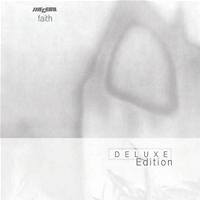
This weekend as I was driving around in the rain with Charlie, I was playing “The Drowning Man” from the Cure’s seminal 1981 release Faith on the car stereo. My friend asked, “Which band is this?” When I told him it was the Cure, he said, “Oh. There have been so many new bands coming out that sound like the Cure, I wasn’t sure whether it was one of them or the real thing.”
Which is to say, this new series of double-disc reissues of the Cure’s early albums, which started last fall with Three Imaginary Boys and continues tomorrow with Seventeen Seconds, Pornography, and Faith, could not come at a more auspicious time. Thanks to bands like Interpol and Bloc Party, which owe debts to Robert Smith’s moody musical style and eccentric vocals respectively, the time is ripe for a rediscovery of the Cure’s legacy. And this series of reissues is definitely the right way to do it.
The sound on this reissue is gorgeously clean. At this point in their history, the revolving Cure line-up was down to a core of three: Smith on vocals and lead, Simon Gallup on bass, and Laurence Tolhurst on drums, with keyboardist Matthieu Hartley abruptly leaving days before the recording session started. Slimmed down to the elemental basics, the band’s playing is honed tight, with Gallup’s big bass sound up front and Smith’s guitars washing over the mix. (For better or worse, this is also the release where, perhaps to fill in some of the gaps in the mix, Smith started reverbing the hell out of his vocals.)
And some of the songs on this disc are stone classics. The major lyrical inspirations for the songs are said to be the death of “several friends and relations” and the terminal illness of Tolhurst’s mother, and that combined with Smith’s meditations on faith and disbelief provide the thematic core for the album. There is a broad sonic range within the basic bleakness of the album: “Primary” and “Other Voices,” which both appear on the excellent Staring at the Sea compilation, are jittery, paranoid fun, as is “Doubt,” while “The Funeral Party,” “The Drowning Man,” and “Faith” are majestic, epic stretches of unremitting rainy darkness. This release is where the Cure found the heart of darkness that was only hinted in earlier songs. The band wouldn’t release another album that was so thoroughly and completely dark until Disintegration closed out their classic period at the end of the 1980s, but the darkness that flowered on Faith is what many still consider to be the Cure’s classic sound, and it would reappear lyrically or musically on almost every other Cure release.
The bonus material is excellent on this release, as with the others in the series. Rounding out Disc 1 is a 27-minute instrumental called “Carnage Visors,” a soundtrack to a 1981 tour film and previously available on the cassette version of Faith. Disc 2 consists of home demos and studio out-takes of the “Faith” material, three previously unreleased songs cut during the Faith sessions, and majestic live performances from the summer of 1981. Disc 2 closes with the Cure’s landmark 1981 single “Charlotte Sometimes,” previously available on the Staring at the Sea compilation, in which the dead ground covered by the Faith sessions yields a sinisterly beautiful flower, a perfect goth pop single.
On April 26, the Cure release expanded editions of Seventeen Seconds, Faith and Pornography. To hear some of the tracks from all three releases, check out The Cure Sampler Listening Party.
If you are going to buy more than one Cure CD and would like to save money, go to the Rhino website.
Review originally posted at BlogCritics.

